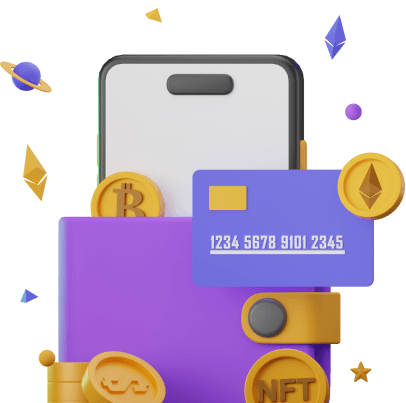How to Create a Crypto Wallet:
A Step-by-Step Guide for Beginners


Cryptocurrencies provide a decentralized and secure method for transactions, and a crypto wallet is the primary tool for managing these digital assets. This guide covers the different types of crypto wallets, how to create one, and best practices for securing your funds.
Understanding Crypto Wallets: Basic Mechanics
A crypto wallet is a digital tool for storing and managing cryptocurrencies. Unlike a traditional wallet holding physical cash, a crypto wallet stores your cryptographic keys: a public key for receiving funds and a private key for sending them. These keys are essential for authorizing transactions on the blockchain.
Types of Crypto Wallets
Hot Wallets
Hot wallets are connected to the internet, offering convenience for frequent transactions. Common types include web wallets accessible via a browser, mobile wallets as smartphone apps, and desktop wallets installed on a computer. While convenient, their online connection makes them more susceptible to cyber threats.
Cold Wallets
Cold wallets are kept offline, providing a higher level of security for long-term storage of digital assets. The main types are hardware wallets—physical devices that store keys offline—and paper wallets, which are physical copies of your public and private keys. Cold wallets are less practical for frequent transactions but are the safest storage option.
Creating a Crypto Wallet
Creating a Web Wallet
To create a web wallet, choose a reputable provider like Coinbase or Binance. You will need to create an account with an email address and a strong password. For enhanced security, complete any identity verification steps and enable two-factor authentication (2FA). The provider will issue a recovery phrase; write it down and store it in a secure offline location. Never share this phrase. Once set up, you can send, receive, and manage your crypto.
Creating a Mobile Wallet
For a mobile wallet, download a trusted app such as Trust Wallet or Exodus from an official app store. When you launch the app, select the option to create a new wallet and follow the prompts. You will be asked to set a PIN and will receive a recovery phrase. Record this phrase carefully and keep it somewhere safe. Enable security features like biometric login for extra protection. You can then transfer funds to your wallet using its public address.
Creating a Desktop Wallet
Creating a desktop wallet requires downloading software like Exodus or Electrum from the official website to your computer. During setup, you will create a new wallet and set a strong password to encrypt it. The software provides a recovery phrase or file; back this up on an external device and store it securely. Always keep the wallet software updated to protect against potential vulnerabilities.
Creating a Hardware Wallet
To set up a hardware wallet, purchase a device directly from an official manufacturer like Ledger or Trezor to avoid tampered products. Connect the device to your computer and follow the setup instructions, which include setting a PIN. The device will generate a recovery phrase. Write it on the provided card and store it safely. Install the companion software on your computer to manage your assets, and always verify transaction details directly on the hardware device's screen before confirming.
Creating a Paper Wallet
To create a paper wallet, use a trusted open-source generator such as BitAddress.org. For maximum security, download the generator and run it on an offline computer. Generate the new public and private keys and print them. Store the printed paper in a secure, dry location, like a fireproof safe. Paper wallets are ideal for long-term storage, as the private key must be imported into a hot wallet to spend the funds.
Best Practices for Crypto Wallet Security
Regardless of the wallet you choose, following these security practices is crucial for protecting your crypto assets:
- Use strong, unique passwords for every account, combining uppercase and lowercase letters, numbers, and symbols.
- Enable two-factor authentication (2FA) whenever available to add an extra layer of security.
- Regularly back up your recovery phrase and private keys, storing them in multiple secure, offline locations.
- Keep your wallet software and related applications updated to patch security vulnerabilities.
- Be cautious of phishing scams. Always verify website URLs and never enter your sensitive information on suspicious sites.
- For significant amounts of cryptocurrency, use a cold storage wallet to minimize exposure to online risks.
Summary
Creating a crypto wallet is the first step to managing your digital assets. By understanding the different wallet types and following a secure setup process, you can safeguard your investments. Always prioritize security by using strong passwords, enabling 2FA, and maintaining secure backups of your recovery phrase. A well-managed wallet provides a safe and effective way to engage with the world of cryptocurrency.
Frequently asked questions
-
What is a crypto wallet?
A crypto wallet is a digital tool that stores your public and private keys, which are necessary to send, receive, and manage your cryptocurrency. It doesn't hold the coins themselves but rather the keys that prove ownership and authorize transactions on the blockchain. -
What is the main difference between a hot wallet and a cold wallet?
A hot wallet (e.g., web, mobile, desktop) is connected to the internet, making it convenient for frequent use but more vulnerable to online threats. A cold wallet (e.g., hardware, paper) is kept offline, offering superior security for long-term storage. -
Why is a recovery phrase so important?
A recovery phrase, or seed phrase, is a list of words that acts as a master backup for your wallet. If you lose access to your device, this phrase is the only way to restore your wallet and recover your funds. It must be kept secret and stored in a secure offline location. -
Are mobile and web wallets safe?
Mobile and web wallets can be secure if you use reputable providers and follow strict security practices, such as using strong passwords, enabling two-factor authentication (2FA), and avoiding phishing scams. For storing significant value, a cold wallet is strongly recommended for its higher security. -
How can I best secure my cryptocurrency?
To best secure your crypto, use a layered approach. Store large amounts in a cold wallet like a hardware device, use strong and unique passwords for all accounts, enable 2FA, keep your recovery phrase secret and offline, and remain vigilant against online scams and phishing attempts.
Our website uses cookies. Our Cookie Policy
